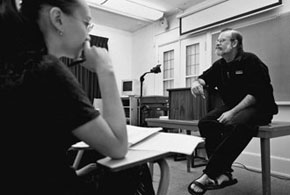Drinking, Not Debauchery
For Anthropologist David Suggs, research on college alcohol use involves going to parties - and discovering a neglected responsible majority
 Walk down the corridors of a residence hall on nearly any American campus late on a Friday night. Of the students you see in those hallways, who are you most likely to notice?
Walk down the corridors of a residence hall on nearly any American campus late on a Friday night. Of the students you see in those hallways, who are you most likely to notice?
Probably the handful of drunk ones, according to David Suggs, professor of anthropology. "You can't miss them--they are loud and obnoxious," he says. "But you don't notice the two hundred other students who walk by, many of whom have been drinking alcohol, but who are not drunk and obnoxious."
It's those two hundred students drinking responsibly who have been ignored by most researchers, Suggs says. He wants to change that. For the past six years, Suggs has studied alcohol use by Kenyon students--the kind that doesn't make headlines, that doesn't result in deadly car crashes or stupid accidents. In short, it is the kind of drinking that many adults enjoy on a regular basis. "If we want to understand collegiate alcohol problems, we first have to understand what is not a problem. We have to understand what leads students to drink alcohol in the first place."
Suggs has approached the research in a typically anthropological way: by doing field research. He has spent many Wednesday and Friday nights in bars, at large fraternity and dorm parties, and at smaller "pre-parties." He has observed social organizations with names like the Friday Afternoon Drinking Club and the Masters of Beer Pong. While this may invoke images of Animal House-style debauchery, the reality is much more mundane, and dare we say it, mature. "Most of the students don't act much like adolescents when they drink; they really are young adults," Suggs says.
That doesn't mean there aren't problems, he emphasizes. But he believes some of the problems we face today are the result of changing the minimum legal drinking age from eighteen to twenty-one in Ohio and around the nation. When the drinking age was eighteen, nearly all college students could drink beer in public, where they learned the concept of "halting points" in front of their friends, their professors, and their neighbors. "As a student, you knew that one of your professors might walk by when you were drinking in a public bar. There were built-in controls to how much you consumed," Suggs says.
Moving the minimum age to twenty-one has not stopped drinking; it has just pushed it underground, where it is more difficult to monitor. One of the consequences is an increase in binge drinking, which is often defined as having five or more drinks in one sitting. But Suggs says that his research suggests that most college students don't binge to get drunk; rather, it is a response to the availability of alcohol in public places.
Students know that they won't have easy access to alcohol in bars or large public parties. As a result, they drink more at the smaller, private pre-parties they attend before they go out. The goal is to drink enough so that when they go to public parties they can maintain a "moderate state of intoxication" for several hours. "For most students, the pre-party drinking is not a problem, even if it is defined as binging," Suggs says. "For a few, it is, particularly when many students come to college without enough experience drinking alcohol to know appropriate halting points."
Suggs says one of the challenges of doing this research has been handling public perceptions. "One of the dilemmas is that some people start thinking you are this advocate for student drinking, and nothing could be further from the truth," he says.
Actually, Suggs's interest in studying alcohol use began long before his focus on college students. For many years in the 1980s, he researched the topic among the people of Botswana, in southern Africa. Many of the issues that he finds among American college students--such as learning halting points--were the same among the young people of Botswana, he says.
In doing his field research in Botswana, as well as at Kenyon, Suggs says he has had to learn to blend into crowds where he was an outsider. "People will ask me how students could accept me when I was with them at parties; didn't I stand out with my white beard and balding head?" Suggs says. "As I told one guy: you think I blended in in Botswana?"
Do you have feedback on this page?
